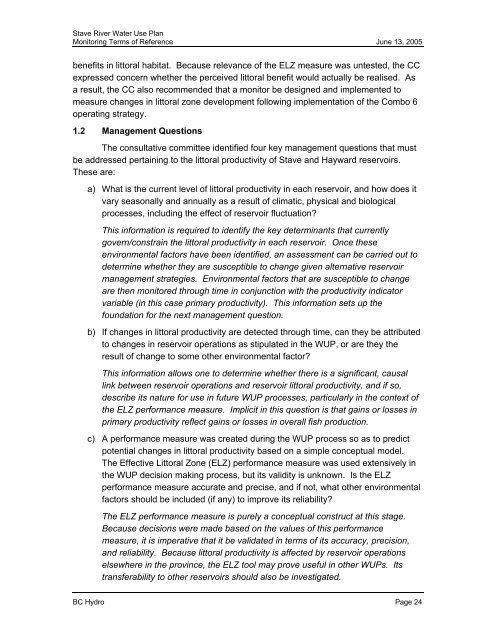Stave River Water Use Plan - BC Hydro
Stave River Water Use Plan - BC Hydro
Stave River Water Use Plan - BC Hydro
You also want an ePaper? Increase the reach of your titles
YUMPU automatically turns print PDFs into web optimized ePapers that Google loves.
<strong>Stave</strong> <strong>River</strong> <strong>Water</strong> <strong>Use</strong> <strong>Plan</strong><br />
Monitoring Terms of Reference June 13, 2005<br />
benefits in littoral habitat. Because relevance of the ELZ measure was untested, the CC<br />
expressed concern whether the perceived littoral benefit would actually be realised. As<br />
a result, the CC also recommended that a monitor be designed and implemented to<br />
measure changes in littoral zone development following implementation of the Combo 6<br />
operating strategy.<br />
1.2 Management Questions<br />
The consultative committee identified four key management questions that must<br />
be addressed pertaining to the littoral productivity of <strong>Stave</strong> and Hayward reservoirs.<br />
These are:<br />
a) What is the current level of littoral productivity in each reservoir, and how does it<br />
vary seasonally and annually as a result of climatic, physical and biological<br />
processes, including the effect of reservoir fluctuation?<br />
This information is required to identify the key determinants that currently<br />
govern/constrain the littoral productivity in each reservoir. Once these<br />
environmental factors have been identified, an assessment can be carried out to<br />
determine whether they are susceptible to change given alternative reservoir<br />
management strategies. Environmental factors that are susceptible to change<br />
are then monitored through time in conjunction with the productivity indicator<br />
variable (in this case primary productivity). This information sets up the<br />
foundation for the next management question.<br />
b) If changes in littoral productivity are detected through time, can they be attributed<br />
to changes in reservoir operations as stipulated in the WUP, or are they the<br />
result of change to some other environmental factor?<br />
This information allows one to determine whether there is a significant, causal<br />
link between reservoir operations and reservoir littoral productivity, and if so,<br />
describe its nature for use in future WUP processes, particularly in the context of<br />
the ELZ performance measure. Implicit in this question is that gains or losses in<br />
primary productivity reflect gains or losses in overall fish production.<br />
c) A performance measure was created during the WUP process so as to predict<br />
potential changes in littoral productivity based on a simple conceptual model.<br />
The Effective Littoral Zone (ELZ) performance measure was used extensively in<br />
the WUP decision making process, but its validity is unknown. Is the ELZ<br />
performance measure accurate and precise, and if not, what other environmental<br />
factors should be included (if any) to improve its reliability?<br />
The ELZ performance measure is purely a conceptual construct at this stage.<br />
Because decisions were made based on the values of this performance<br />
measure, it is imperative that it be validated in terms of its accuracy, precision,<br />
and reliability. Because littoral productivity is affected by reservoir operations<br />
elsewhere in the province, the ELZ tool may prove useful in other WUPs. Its<br />
transferability to other reservoirs should also be investigated.<br />
<strong>BC</strong> <strong>Hydro</strong> Page 24
















